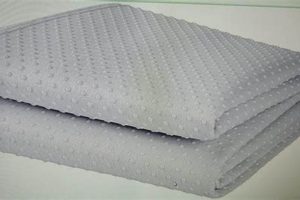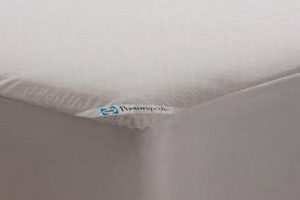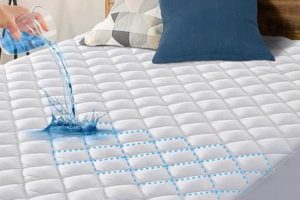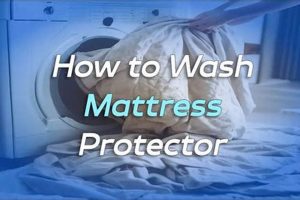These accessories function as fitted sheets or zippered encasements designed to shield a bed’s primary sleeping surface. Their construction often incorporates water-resistant or waterproof materials, alongside features targeting allergen mitigation, stain prevention, and overall hygiene maintenance. For instance, a waterproof model safeguards against spills, while allergen-resistant variants minimize dust mite accumulation.
The adoption of these protective layers extends the lifespan of mattresses by preventing wear and tear from everyday use and accidental damage. Furthermore, their use contributes significantly to a healthier sleep environment. Historically, such safeguarding measures evolved from simple fabric sheets into technologically advanced materials boasting breathability and enhanced protective capabilities.
Understanding the varied types, materials, and specialized features available is crucial in selecting the optimal option for individual needs. Subsequent sections will delve into these aspects, providing a detailed exploration of the market and its associated considerations.
Guidance on Selecting and Utilizing Mattress Safeguards
Effective selection and maintenance of these items are essential for maximizing their benefits and ensuring long-term mattress protection. The following guidance provides practical advice for consumers.
Tip 1: Assess Material Composition: Prioritize breathable materials such as cotton or bamboo to avoid trapping heat and moisture, which can compromise sleep comfort and foster microbial growth. Waterproof polyurethane layers should be discreet and allow for sufficient airflow.
Tip 2: Determine Allergen Protection Needs: Individuals with allergies should opt for products specifically designed to block dust mites and other common allergens. Tightly woven fabrics with small pore sizes are most effective in this regard.
Tip 3: Evaluate Waterproofing Requirements: For households with children or pets, a completely waterproof option is advisable. However, ensure the material is breathable to prevent discomfort and overheating.
Tip 4: Consider Encasement vs. Fitted Style: Encasements, which fully enclose the mattress, offer comprehensive protection against bed bugs and allergens. Fitted styles, similar to fitted sheets, provide protection primarily to the top surface.
Tip 5: Verify Proper Fit: Accurate measurements of the mattress are crucial to ensure a snug and secure fit. Overly loose or tight coverings can compromise their protective capabilities.
Tip 6: Adhere to Washing Instructions: Regular laundering according to the manufacturer’s instructions is essential for maintaining hygiene and removing accumulated allergens and stains. High temperatures may be necessary for effective sanitation.
Tip 7: Replace Periodically: Over time, these protective layers can degrade and lose their effectiveness. Replacing them every one to two years, or as needed, is recommended to maintain optimal protection.
By adhering to these guidelines, individuals can optimize the performance and longevity of their sleep surfaces, contributing to a cleaner and healthier sleep environment.
The subsequent sections will discuss common issues and frequently asked questions related to the use of these products.
1. Waterproof Capabilities
Waterproof capabilities represent a primary functional attribute of many accessories designed to protect mattresses. This characteristic aims to prevent liquids from penetrating the mattress core, thereby mitigating damage and maintaining hygiene. The integration of effective waterproofing is crucial for extending the lifespan of the mattress and minimizing potential health risks associated with liquid exposure.
- Barrier Composition
The efficacy of waterproof attributes relies heavily on the composition of the protective layer. Materials such as polyurethane films or specialized waterproof fabrics are commonly employed. These materials form an impermeable barrier against liquids, preventing absorption into the mattress fibers. The choice of material directly impacts the level of protection and the breathability of the product.
- Seam Construction
The integrity of seams plays a crucial role in maintaining waterproof performance. Poorly constructed seams can act as entry points for liquids, compromising the overall protective function. Reinforced or taped seams are often incorporated to enhance the waterproof seal and prevent leakage along these vulnerable areas.
- Breathability Considerations
While waterproofing is essential, breathability remains a critical factor for user comfort. Completely impermeable barriers can trap heat and moisture, leading to discomfort and potentially promoting microbial growth. Advanced waterproof materials often incorporate microporous structures that allow for air circulation while preventing liquid penetration. This balance between protection and breathability is essential for optimal performance.
- Maintenance Protocols
The longevity of waterproof capabilities depends significantly on proper maintenance. Regular cleaning according to the manufacturer’s instructions is essential for preventing the breakdown of waterproof barriers. Harsh chemicals or abrasive cleaning methods can damage the protective layer, reducing its effectiveness over time. Adherence to recommended care protocols ensures sustained waterproof performance.
These facets underscore the importance of selecting accessories with robust and well-maintained waterproof capabilities. The level of protection, seam integrity, breathability, and adherence to maintenance protocols collectively influence the longevity and effectiveness of the mattress safeguarding. Therefore, consumers should carefully evaluate these aspects when choosing suitable products.
2. Allergen Barrier
The integration of an effective allergen barrier is a critical function of specialized mattress accessories. The primary cause-and-effect relationship is straightforward: the presence of a functional barrier reduces exposure to allergens, thus mitigating allergic reactions. For instance, a tightly woven fabric encasement significantly diminishes dust mite populations within the mattress, directly reducing the source of a common allergen.
The importance of this barrier stems from the prevalence of allergies and respiratory sensitivities. Without a protective layer, allergens like dust mite feces, pet dander, and mold spores can readily accumulate in the mattress, creating an environment conducive to allergic reactions. A real-life example involves individuals with asthma experiencing fewer nocturnal symptoms after switching to allergen-impermeable mattress encasements. These individuals often report improved sleep quality and reduced reliance on medication.
In summary, the allergen barrier component within mattress protectors serves as a proactive measure to control allergen exposure, offering tangible health benefits. The challenge lies in ensuring the barrier remains intact and effective over time, necessitating regular cleaning and periodic replacement of the accessory. Understanding this connection empowers consumers to make informed choices, prioritizing mattress protection that genuinely enhances sleep hygiene and respiratory health.
3. Material Breathability
Material breathability, pertaining to mattress accessories, refers to the capacity of the fabric to permit air and moisture vapor to pass through it. This property directly influences sleeping comfort and the overall hygiene of the sleep environment. A lack of breathability can trap body heat and perspiration, leading to overheating, discomfort, and the potential for microbial growth within the mattress core. Conversely, breathable materials facilitate the evaporation of moisture, maintaining a drier and cooler sleep surface. For example, accessories constructed from tightly woven synthetic fibers often exhibit poor breathability compared to those made from natural fibers like cotton or bamboo.
The importance of material breathability extends beyond mere comfort. A damp environment within a mattress fosters the proliferation of mold, mildew, and dust mites, exacerbating allergies and respiratory issues. Therefore, the selection of breathable mattress protection becomes particularly critical for individuals with sensitivities or pre-existing respiratory conditions. Consider a scenario where a waterproof protector, lacking adequate breathability, is used in a humid climate. The resulting build-up of moisture within the mattress creates an ideal breeding ground for mold, potentially triggering allergic reactions in susceptible individuals.
In summary, material breathability constitutes a vital consideration when evaluating mattress accessories. Its impact on comfort, hygiene, and allergen control is significant. While waterproof capabilities are often prioritized, neglecting breathability can negate the benefits of protection and even introduce new problems. The informed consumer recognizes the necessity of balancing these attributes to optimize sleep quality and mattress longevity.
4. Secure Fit
A secure fit constitutes a critical performance characteristic of mattress covers and protectors, directly influencing their protective efficacy. An ill-fitting accessory, irrespective of its material composition or specialized features, compromises its intended function. The cause-and-effect relationship is straightforward: a loose or improperly sized cover allows for movement, creating gaps and exposing the mattress to potential contaminants, spills, and wear. Conversely, a securely fitted cover remains taut and in place, providing consistent and comprehensive protection across the entire mattress surface. A real-world example involves a mattress cover that shifts during sleep, leaving sections of the mattress vulnerable to staining or dust mite accumulation, effectively negating the benefits of the product.
The importance of a secure fit extends to the prevention of premature wear and tear. A loose-fitting cover is prone to bunching and friction, accelerating the degradation of both the cover itself and the mattress beneath. Furthermore, a secure fit contributes to a more comfortable and stable sleeping surface. A properly fitted cover minimizes noise and prevents the sensation of slipping or shifting, enhancing overall sleep quality. This is particularly significant for individuals with sensitive sleep patterns or those prone to tossing and turning during the night. Consider a scenario where an individual experiences disrupted sleep due to the constant readjustment of a poorly fitted mattress protector. The resultant sleep deprivation can have cascading effects on their overall health and well-being.
In conclusion, a secure fit is not merely a cosmetic detail but an integral component of mattress protection. It ensures consistent coverage, prevents movement, and contributes to both the longevity of the mattress and the quality of sleep. While material quality and specialized features are important considerations, the significance of a secure fit should not be overlooked. Accurate measurements and careful selection of appropriately sized covers are essential for realizing the full protective benefits of these accessories.
5. Easy Maintenance
Easy maintenance represents a crucial attribute of mattress covers and protectors, directly impacting their long-term utility and hygiene. The ease with which these items can be cleaned and maintained significantly influences their effectiveness in safeguarding the mattress and promoting a healthy sleep environment. Neglecting this factor can negate the benefits of protection, leading to unsanitary conditions and premature product degradation.
- Machine Washability
Machine washability stands as a primary indicator of easy maintenance. The ability to launder a mattress cover or protector in a standard washing machine simplifies the cleaning process and encourages regular hygiene practices. Covers requiring specialized cleaning methods or hand-washing are less likely to be maintained consistently, increasing the risk of allergen accumulation and staining. For example, a spill on a machine-washable cover can be quickly addressed, preventing permanent damage and maintaining a sanitary sleep surface.
- Drying Considerations
Drying methods also contribute to ease of maintenance. Covers that are dryer-safe offer added convenience, allowing for rapid and efficient cleaning cycles. Air-drying, while sometimes necessary for delicate materials, can be time-consuming and impractical. Furthermore, prolonged drying times increase the risk of microbial growth. Dryer-safe covers, on the other hand, can be thoroughly dried, ensuring complete sanitation and minimizing the potential for mold or mildew formation. An example would be using a dryer with a low-heat setting to sanitize a protector without damaging its waterproof membrane.
- Stain Resistance
The inherent stain resistance of the cover material contributes significantly to ease of maintenance. Materials that repel stains require less frequent and less intensive cleaning. Covers treated with stain-resistant finishes or constructed from inherently stain-resistant fibers simplify the removal of spills and accidents, preserving their appearance and functionality. Consider a scenario where a stain-resistant cover easily wipes clean after a minor spill, eliminating the need for extensive washing and preserving its integrity.
- Durability and Longevity
The durability and longevity of a mattress cover directly impact its maintenance requirements. Covers constructed from high-quality materials are less prone to tearing, shrinking, or losing their protective properties over time. This reduces the need for frequent replacements and ensures consistent performance throughout their lifespan. A durable cover, capable of withstanding repeated washing cycles, provides long-term value and minimizes maintenance-related expenses. For instance, a protector with reinforced seams and high-quality waterproofing will resist wear and tear from repeated washing better than a cheap, poorly-made alternative.
These facets underscore the importance of prioritizing easy maintenance when selecting mattress covers and protectors. Machine washability, drying considerations, stain resistance, and durability collectively contribute to the long-term effectiveness and hygiene of these essential sleep accessories. By considering these factors, consumers can ensure that their chosen covers remain clean, functional, and protective for years to come, contributing to a healthier and more comfortable sleep environment.
Frequently Asked Questions about Mattress Covers and Protectors
This section addresses common inquiries regarding the function, selection, and maintenance of mattress covers and protectors. The aim is to provide clarity and inform decision-making.
Question 1: What is the primary purpose of utilizing a mattress cover or protector?
The principal function involves safeguarding the mattress against spills, stains, allergens, and dust mites, thereby extending its lifespan and promoting a more hygienic sleep environment.
Question 2: Are all mattress covers waterproof?
No, not all mattress covers offer waterproof protection. Some are water-resistant, providing a degree of protection against minor spills, while others are solely designed for allergen control or general hygiene. Waterproof models offer the highest level of protection against liquid damage.
Question 3: How often should a mattress cover or protector be washed?
Washing frequency depends on individual circumstances and usage patterns. However, as a general guideline, laundering every one to two months is recommended to remove accumulated allergens, dust mites, and body oils. More frequent washing may be necessary in households with children, pets, or allergy sufferers.
Question 4: Can a mattress cover prevent bed bug infestations?
While not a guaranteed solution, certain types of mattress encasements, specifically those designed with bed bug-proof zippers and seams, can effectively prevent bed bugs from infesting the mattress. These encasements fully enclose the mattress, denying bed bugs access to their preferred hiding places.
Question 5: Will a mattress cover alter the feel of the mattress?
Depending on the material and thickness, a mattress cover can subtly alter the feel of the mattress. Thicker covers may provide a slightly plusher surface, while thinner covers may have a negligible impact. Selecting a cover that aligns with individual comfort preferences is advisable.
Question 6: How does one determine the appropriate size of a mattress cover?
Accurate measurement of the mattress is crucial for selecting the correct size. Measure the length, width, and depth of the mattress, and choose a cover that corresponds to these dimensions. A snug and secure fit is essential for optimal protection.
Key takeaways include the importance of understanding the different types of covers available, selecting a model that aligns with specific needs, and maintaining the cover through regular cleaning.
The subsequent section will address potential problems and issues related to the usage of mattress covers and protectors.
Mattress Covers and Protectors
The preceding discussion has explored the multifaceted role of mattress covers and protectors in maintaining both the integrity and sanitation of sleep surfaces. Key aspects examined include waterproof capabilities, allergen barriers, material breathability, secure fit, and ease of maintenance. These elements collectively contribute to extending mattress lifespan and fostering a healthier sleep environment. Proper selection and consistent upkeep are paramount to realizing the full benefits of these protective accessories.
Given the significant investment represented by a mattress, and the direct impact sleep quality has on overall well-being, the strategic utilization of mattress covers and protectors constitutes a prudent measure. A proactive approach to mattress care ensures long-term value and promotes a consistently hygienic and comfortable sleep experience, a worthwhile consideration for any discerning consumer.




![Cool Tempur-Pedic Comfort: Cooling Mattress Protector [Guide] Organic & Natural Mattress Buyer’s Guide: Non-Toxic Sleep Solutions Cool Tempur-Pedic Comfort: Cooling Mattress Protector [Guide] | Organic & Natural Mattress Buyer’s Guide: Non-Toxic Sleep Solutions](https://mattressworldpa.com/wp-content/uploads/2025/07/th-2523-300x200.jpg)


